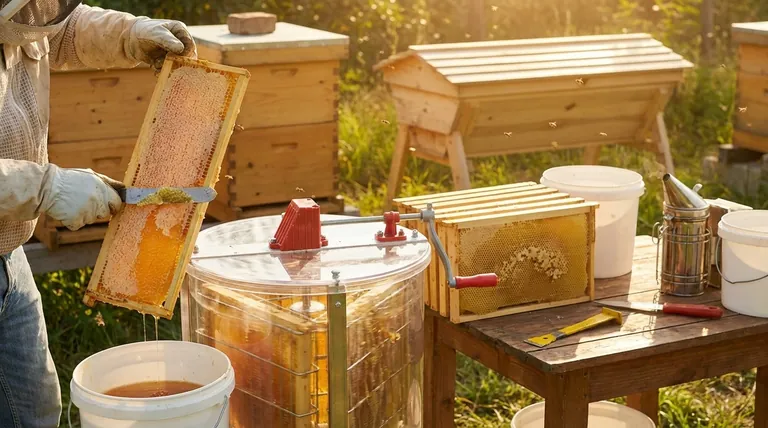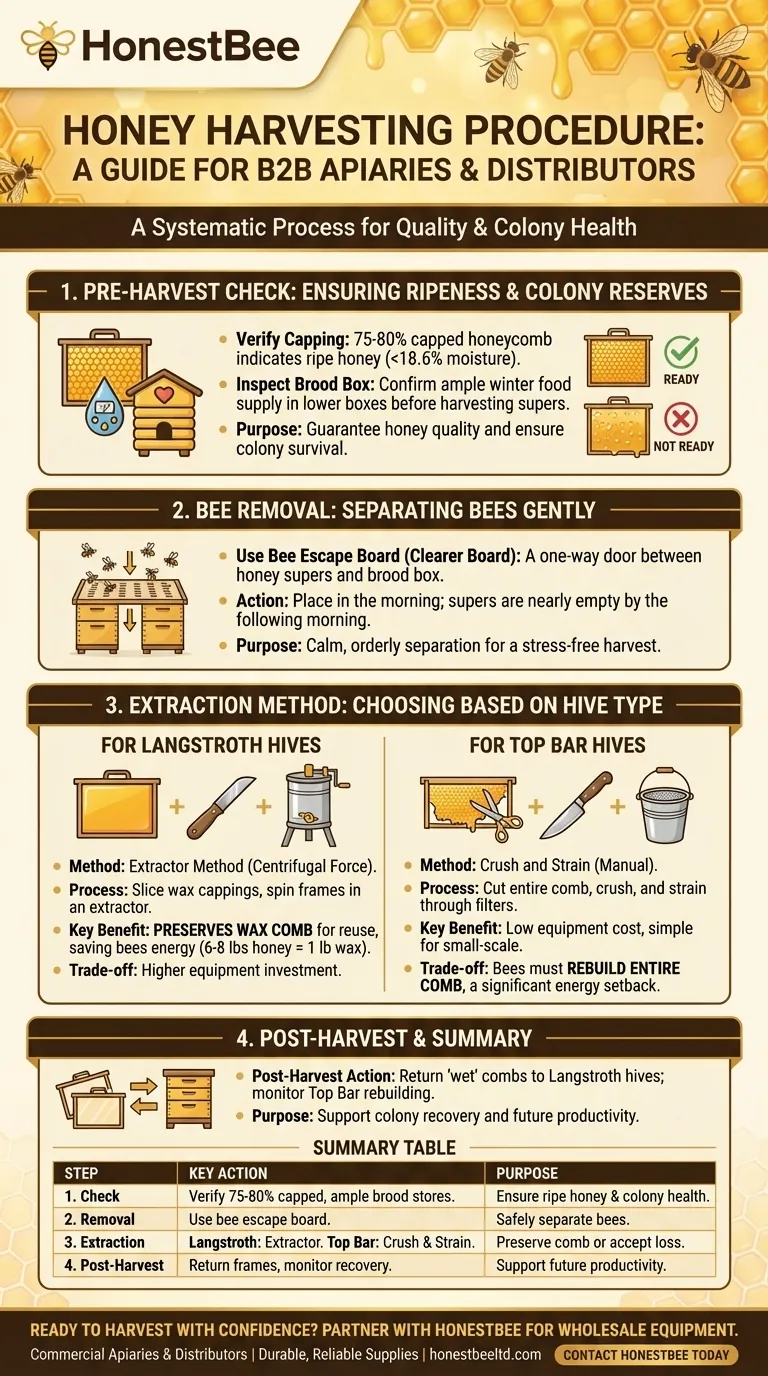Harvesting honey is a systematic process that begins with ensuring the honey is ripe and ends with separating it from the wax comb. The core steps involve identifying fully or partially capped honeycomb, clearing the bees from the honey frames or bars, removing them from the hive, and then using a specific method—either extraction or crushing—to get the pure honey.
The most critical decision in honey harvesting is choosing the correct extraction method for your hive type. While the goal is to collect honey, the overriding principle is to do so in a way that prioritizes the long-term health and productivity of the bee colony.

The Foundational Step: Is Your Honey Ready?
Before you bring any tools near the hive, you must first determine if the honey is ready for harvest and if the colony can spare it. This is the most crucial step for both the quality of your honey and the survival of your bees.
Identifying Ripe, Capped Honey
Honey isn't ready until the bees decide it is. They signal this by capping the honeycomb cell with a fresh layer of beeswax.
This capping indicates the honey has the correct moisture content (typically below 18.6%). Harvesting uncapped, or "unripe," honey can lead to fermentation and spoilage. A frame is generally considered ready when it is at least 75-80% capped over.
Checking the Brood Box First
The honey in the upper boxes (the "supers") is surplus. The honey in the lower "brood boxes" is the bees' essential food supply for winter.
Before taking any honey from the supers, you must inspect the brood chambers. If you find little to no honey stored there, do not harvest. Taking their surplus when they have no reserves can lead to the colony starving.
Separating Bees from the Honey
Once you've confirmed the honey is ready, the next step is to clear the bees from the honey supers you intend to harvest. A calm, orderly removal is far better than an agitated one.
The Bee Escape Board Method
The most patient and gentle method is using a bee escape board, also known as a clearer board.
This is a one-way door placed between the honey supers and the brood box below. Bees can travel down into the brood chamber but cannot get back up into the super. If you place the board in the morning, the super should be nearly empty of bees and ready for harvest the following morning.
The Two Core Extraction Methods: Hive Type Matters
How you get honey out of the comb depends entirely on the type of hive you manage. The two main approaches have significant implications for your bees and your equipment needs.
For Langstroth Hives: The Extractor Method
Langstroth hives use rectangular frames that are designed to be reused. The goal here is to remove the honey while preserving the delicate wax comb.
First, a thin layer of wax cappings is sliced off the comb with an uncapping knife. The frames are then placed in a honey extractor, a machine that uses centrifugal force to spin the honey out of the cells without destroying the comb. These empty "wet" combs are then returned to the hive for the bees to refill, saving them an immense amount of energy.
For Top Bar Hives: The Crush and Strain Method
Top bar hives do not use formal frames. Instead, the entire comb is cut from the top bar it hangs from. This method is simpler and requires no special machinery.
The comb is cut from the bar and placed in a container where it is crushed. The resulting mixture of honey and wax is then poured through a series of strainers or filters to separate the honey.
Understanding the Trade-offs
Each harvesting method presents a different balance of equipment cost, labor, and impact on the colony.
Efficiency vs. Colony Effort
The extractor method used for Langstroth hives is highly efficient for the bees. Since they don't have to rebuild the comb from scratch, they can begin storing new honey almost immediately. It is estimated that bees consume 6-8 pounds of honey to produce just one pound of wax.
The crush and strain method, while simple for the beekeeper, forces the colony to expend significant resources rebuilding the entire comb. This represents a setback in the hive's productivity.
Equipment Investment vs. Simplicity
Harvesting from a Langstroth hive requires a significant upfront investment in a honey extractor.
Conversely, the top bar crush and strain method is far less expensive. All you need is a sharp knife, food-grade buckets, and a simple straining system, making it very accessible for new beekeepers.
Making the Right Choice for Your Hive
Your harvesting procedure should be guided by your hive type and a commitment to responsible beekeeping.
- If you use a Langstroth hive: Your primary goal is to preserve the drawn-out comb. Using an extractor is the standard practice and best supports your colony's long-term productivity.
- If you use a Top Bar hive: Embrace the simplicity of the crush and strain method, but be mindful that you are removing both honey and comb, and only do so when the colony is exceptionally strong.
- If you are a first-time harvester: Prioritize the pre-harvest inspection. Confirming that the honey is capped and, most importantly, that the brood box has ample food stores is the defining mark of a responsible beekeeper.
Ultimately, a successful harvest is one that rewards your efforts while ensuring your colony remains strong and healthy for the season ahead.
Summary Table:
| Step | Key Action | Purpose |
|---|---|---|
| 1. Pre-Harvest Check | Verify honey is 75-80% capped and brood box has ample food. | Ensure honey is ripe and colony health is not compromised. |
| 2. Bee Removal | Use a bee escape board to gently clear bees from honey supers. | Safely and calmly separate bees from the harvestable frames. |
| 3. Extraction Method | Langstroth: Use an extractor. Top Bar: Use crush and strain. | Remove honey while preserving comb (Langstroth) or accepting comb loss (Top Bar). |
| 4. Post-Harvest | Return empty frames to Langstroth hives; monitor Top Bar hives for comb rebuilding. | Support colony recovery and future productivity. |
Ready to Harvest with Confidence?
A successful harvest depends on having the right, high-quality equipment. Whether you manage a large-scale commercial apiary or are a distributor supplying beekeepers, HONESTBEE has the durable, reliable supplies you need.
We provide wholesale-focused solutions for:
- Commercial Apiaries: Maximize your honey yield and protect your investment with our robust Langstroth hive components and extractors.
- Beekeeping Equipment Distributors: Stock your shelves with our trusted range of harvesting tools, from uncapping knives to strainers.
Let us help you support healthy, productive colonies. Contact HONESTBEE today to discuss your wholesale equipment needs!
Visual Guide

Related Products
- HONESTBEE 3-Frame Manual Acrylic Honey Extractor
- electric honey extractor honey centrifuge 3 frame honey extractor stainless steel honey frame extractor
- HONESTBEE 72 Frame Industrial Electric Honey Extractor for Beekeeping
- 40 Frame Commercial Electric Honey Extractor for Beekeeping
- 6 Frame Manual Stainless Steel Honey Extractor Beekeeping Equipment
People Also Ask
- How do you collect honey at home? A Beginner's Guide to Harvesting from Your Hive
- What equipment is used for honey harvest? Essential Tools for Every Beekeeper
- How do you manually extract honey? Choose the Best Method for Your Hive
- What is a fun and easy alternative to using a honey extractor for harvesting honey? Try the Crush and Strain Method
- What is the most common method for cleaning a honey extractor? Protect Your Honey & Equipment



















